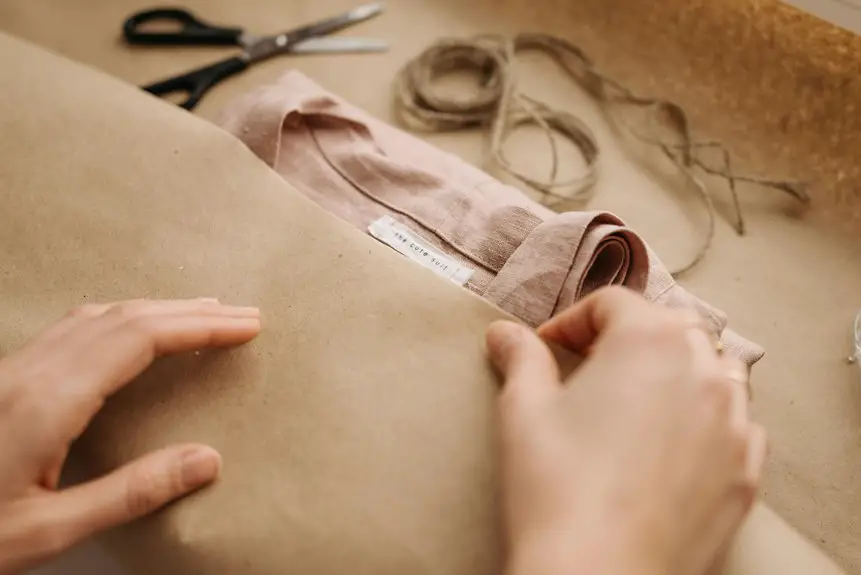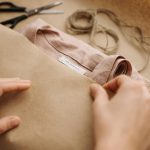You’ll want to handle your camel hair garments gently to keep their softness and shape. Brush lightly after wearing, air them out, and store in cool, dry places using padded hangers within breathable bags. For cleaning, spot clean when possible, hand wash with cool water and mild detergent, or choose professional dry cleaning for delicate pieces. Avoid wringing or heat when drying. These care habits will keep your camel hair looking elegant and cozy; more detailed tips can help you maintain their luxurious feel longer.
Table of Contents
Key Takeaways
- Handle camel hair garments gently and store them in a cool, dry place away from sunlight to preserve softness and shape.
- Brush garments with a soft-bristle brush after wear and air them out regularly to maintain freshness and remove surface dirt.
- Spot clean when possible; for washing, hand wash with cool water and mild wool detergent, avoiding rubbing or wringing.
- Prefer professional dry cleaning for delicate or lined garments, typically once or twice per season, to prevent shrinkage and remove deep stains.
- Store garments on wide, padded hangers in breathable cotton bags with cedar blocks or lavender sachets to protect against pests and moisture.
Understanding the Unique Qualities of Camel Hair Fabric
Camel hair fabric stands out for its exceptional softness and natural warmth, making it a popular choice for luxurious garments.
When you wear camel hair, you’ll notice its smooth texture and lightweight feel, yet it provides impressive insulation against cold weather.
Unlike synthetic fibers, camel hair is breathable, allowing moisture to escape while keeping you cozy.
Its fibers come from the undercoat of camels, which naturally protects them in harsh climates, giving the fabric durability and resilience.
You should also know that camel hair fabric has a natural sheen and drapes beautifully, enhancing your garment’s elegance.
Understanding these qualities helps you appreciate why camel hair requires gentle care to maintain its softness, warmth, and appearance over time.
Routine Maintenance Tips for Camel Hair Garments
Because camel hair fabric is delicate, you should handle your garments with care to keep them looking their best.
Handle camel hair garments gently to preserve their delicate beauty and ensure lasting wear.
Always store them in a cool, dry place away from direct sunlight to prevent fading and damage. Use padded hangers to maintain shape and avoid stretching.
Brush your camel hair clothes gently with a soft-bristle garment brush after wearing to remove dust and surface dirt. Avoid wearing the same garment consecutively to allow the fibers to rest and regain their natural resilience.
If you spot minor stains, blot them immediately with a clean cloth—don’t rub. Regularly airing out your garments helps keep them fresh without washing too often, which can weaken fibers.
Following these tips will extend the life and appearance of your camel hair pieces.
How to Safely Hand Wash Camel Hair Clothes
A gentle hand wash can refresh your camel hair garments without risking damage.
Start by filling a basin with cool water and add a small amount of mild wool detergent. Submerge the garment and gently swirl it around for a few minutes—avoid rubbing or wringing, which can distort the fibers.
After soaking, rinse thoroughly with cool water until no soap remains. To remove excess water, press the garment gently between two clean towels; don’t twist or wring it out.
Lay the camel hair piece flat on a dry towel, reshaping it to its original form, and let it air dry away from direct sunlight or heat sources.
This careful hand washing method helps maintain softness and prolongs the life of your camel hair clothes.
Professional Dry Cleaning: When and Why It’s Necessary
While gentle hand washing works well for regular upkeep, some camel hair garments require professional care to keep them in top condition.
You should opt for professional dry cleaning if your garment has intricate details, linings, or if the care label explicitly recommends it.
Dry cleaning effectively removes deep-seated dirt and oils without damaging the delicate fibers. It also prevents shrinkage and maintains the fabric’s natural softness and structure.
Dry cleaning removes deep dirt and oils while preserving camel hair’s softness, structure, and preventing shrinkage.
If you notice stubborn odors or stains that you can’t safely treat at home, it’s best to trust a professional.
Regular dry cleaning intervals depend on how often you wear the item, but usually once or twice a season suffices.
Best Practices for Stain Removal on Camel Hair Fabric
When a stain hits your camel hair garment, act quickly to prevent it from setting.
Use gentle, suitable cleaning agents designed for delicate fabrics to treat the spot carefully.
After cleaning, let the fabric air dry completely and maintain it properly to keep your garment looking its best.
Immediate Stain Treatment
Since camel hair fabric is delicate and prone to staining, you should act quickly to treat any spills or marks.
First, gently blot the stain with a clean, dry cloth to absorb excess liquid—avoid rubbing, which can push the stain deeper. If the stain is solid, carefully lift off any residue using a spoon or blunt edge without pressing it further into the fibers.
Next, dampen a cloth with cool water and lightly dab the area to dilute the stain, again avoiding harsh rubbing. Always test any moisture on a hidden area first to verify it doesn’t damage the fabric.
Prompt, gentle attention helps prevent stains from setting, preserving your garment’s appearance until you can apply more thorough cleaning methods later.
Suitable Cleaning Agents
Although camel hair fabric requires gentle care, you can still use specific cleaning agents to tackle stains effectively. Choose mild, wool-safe detergents or specialized stain removers designed for delicate fabrics. Avoid harsh chemicals, bleach, or anything with enzymes that might damage the fibers. Test any product on a hidden area before applying it to the stain.
Here’s a quick guide to suitable cleaning agents:
| Agent Type | Usage | Precaution |
|---|---|---|
| Wool-safe detergent | Dilute with water, gently dab | Avoid soaking |
| Stain remover (delicate) | Apply sparingly on stain | Patch test first |
| White vinegar | Mix with water, mild solution | Use only on colorfast fabric |
Using these agents carefully helps preserve your camel hair garment’s softness and look.
Drying and Maintenance
If you want to maintain your camel hair garment’s quality after stain removal, drying it properly is essential.
Avoid wringing or twisting the fabric; instead, gently press out excess water with a clean towel. Lay the garment flat on a dry towel in a well-ventilated area, away from direct sunlight or heat sources, which can damage fibers. Never use a tumble dryer.
For maintenance, store your camel hair clothes in a cool, dry place and use padded hangers to preserve their shape. Brush your garment regularly with a soft-bristle brush to remove dust and prevent dirt buildup.
Promptly treat any new stains to avoid permanent damage, and consider professional cleaning for stubborn spots to keep your camel hair fabric looking pristine.
Proper Drying Techniques to Preserve Shape and Texture
When you finish washing your camel hair garment, you’ll want to dry it carefully to maintain its shape and texture. Avoid wringing or twisting; instead, gently press out excess water. Lay the garment flat on a clean towel, reshaping it to its original form. Keep it away from direct sunlight or heat sources to prevent damage.
| Technique | What to Do | What to Avoid |
|---|---|---|
| Water Removal | Press gently with towel | Wringing or twisting |
| Drying Location | Flat on a towel indoors | Direct sunlight |
| Reshaping | Gently reshape garment | Hanging while wet |
Following these steps helps your camel hair stay soft and keeps its structure intact.
Storing Camel Hair Garments to Prevent Damage
To keep your camel hair garments in great shape, you need to store them in a cool, dry place away from direct sunlight.
Use padded hangers to maintain their shape and avoid stretching the fabric.
Don’t forget to protect them from pests by using cedar blocks or mothballs in your closet.
Ideal Storage Environment
Although camel hair fabric is durable, improper storage can cause it to lose its softness and shape. You’ll want to keep your garments in a cool, dry place away from direct sunlight and moisture. Avoid plastic bags, which trap humidity and encourage mildew. Instead, opt for breathable cotton garment bags.
Here’s a quick guide for your ideal storage environment:
| Factor | Recommended Condition | Why It Matters |
|---|---|---|
| Temperature | 60-70°F (15-21°C) | Prevents fiber weakening |
| Humidity | 40-50% | Stops mold and mildew growth |
| Light Exposure | Minimal to none | Avoids color fading |
| Airflow | Good ventilation | Reduces moisture buildup |
| Storage Bags | Breathable cotton preferred | Allows fabric to breathe |
Following this will keep your camel hair garments looking their best.
Proper Hanging Techniques
Keeping your camel hair garments in the right environment is just one part of preserving their quality. Proper hanging techniques play an essential role in maintaining their shape and preventing damage.
Use wide, padded hangers to support the shoulders and avoid stretching the fabric. Make sure the hangers are sturdy enough to hold the garment’s weight without bending. When hanging, leave enough space between items to allow air circulation and prevent wrinkles.
Avoid wire hangers, as they can cause misshaping and creasing. For longer camel hair coats, consider using a hanger with a bar to support the bottom, preventing the fabric from sagging.
Protection Against Pests
Since camel hair is a natural fiber, it attracts pests like moths that can cause serious damage to your garments. To protect your camel hair clothing, store them in airtight containers or garment bags made from breathable materials like cotton.
Avoid plastic bags, which trap moisture and encourage mold growth. Use cedar blocks or lavender sachets inside your storage to repel moths naturally without harsh chemicals.
Make sure your garments are clean before storing; dirt and sweat attract pests. Regularly check your stored items for signs of damage or infestation.
Finally, store your camel hair pieces in a cool, dry place away from direct sunlight to maintain their quality and prevent pest issues. Taking these steps will keep your garments safe and looking great.
Repairing Minor Damage and Loose Fibers
When you notice minor damage or loose fibers on your camel hair garment, addressing them promptly can prevent further wear.
Taking quick action helps maintain its elegant appearance and extends its lifespan. Here’s what you can do:
Taking quick action preserves your garment’s elegance and durability for years to come.
- Gently trim any loose fibers with sharp scissors to avoid pulling.
- Use a fabric shaver or lint roller carefully to remove pills or fuzz.
- For small holes or tears, sew them with a needle and thread matching the fabric color.
- Apply a fabric adhesive or patch for tiny holes if sewing isn’t an option.
Tips for Keeping Camel Hair Fabric Soft and Fresh
Although camel hair fabric is naturally soft, you’ll want to take extra care to maintain its delicate texture and freshness. To keep it feeling plush, avoid frequent washing—spot clean when possible instead.
Use a soft brush to gently remove surface dirt and revive the fibers. When laundering, always opt for a gentle cycle with cold water and mild detergent, or hand wash to preserve softness.
After washing, reshape the garment and dry it flat away from direct sunlight or heat sources to prevent stiffness.
Store your camel hair items in a breathable garment bag to protect them from dust and moisture, and use cedar blocks or lavender sachets to keep them fresh.
Following these tips guarantees your camel hair fabric stays irresistibly soft and fresh for years.
Frequently Asked Questions
Can Camel Hair Fabric Be Machine Washed Safely?
You shouldn’t machine wash camel hair fabric because it can shrink or get damaged. Instead, you should dry clean or hand wash gently with cold water and mild detergent to keep your garment looking great and lasting longer.
How Does Camel Hair Compare to Cashmere in Warmth?
You’d think camel hair’s warmth could rival the sun itself—it’s incredibly insulating! Compared to cashmere, camel hair’s thicker fibers trap more heat, so you’ll stay toasty longer, especially in those biting, frosty winter winds.
Are Camel Hair Garments Hypoallergenic?
Camel hair garments are generally hypoallergenic because the fibers are natural and less likely to irritate sensitive skin. However, if you’re allergic to animal fibers, you might still experience some reactions, so test first if unsure.
Can Camel Hair Fabric Be Used for Upholstery?
Did you know camel hair is 30% warmer than sheep’s wool? Yes, you can use camel hair fabric for upholstery—it’s durable, luxurious, and adds warmth. Just guarantee proper cleaning to maintain its softness and longevity.
What Is the Environmental Impact of Camel Hair Production?
You’ll find camel hair production has a relatively low environmental impact since it’s a natural, renewable fiber gathered during molting without harming camels, requiring less water and chemicals compared to synthetic fabrics or intensive livestock farming.
- Does Chiffon Fabric Stink - July 15, 2025
- Does Chiffon Fabric Affect the Economy - July 15, 2025
- Does Cotton Fabric Have a Nap - July 15, 2025







